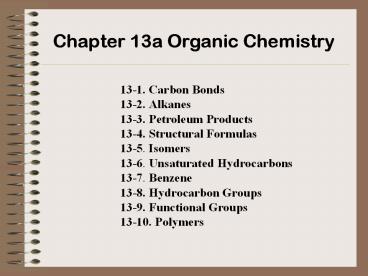Chapter 13a Organic Chemistry - PowerPoint PPT Presentation
1 / 32
Title:
Chapter 13a Organic Chemistry
Description:
Chapter 13a Organic Chemistry 13-1. Carbon Bonds 13-2. Alkanes 13-3. Petroleum Products 13-4. Structural Formulas 13-5. Isomers 13-6. Unsaturated Hydrocarbons – PowerPoint PPT presentation
Number of Views:537
Avg rating:3.0/5.0
Title: Chapter 13a Organic Chemistry
1
Chapter 13a Organic Chemistry
13-1. Carbon Bonds13-2. Alkanes 13-3. Petroleum
Products 13-4. Structural Formulas 13-5.
Isomers 13-6. Unsaturated Hydrocarbons13-7.
Benzene 13-8. Hydrocarbon Groups 13-9.
Functional Groups 13-10. Polymers
2
Organic chemistry is the chemistry of carbon
compounds inorganic chemistry is the chemistry
of compounds of all elements other than carbon.
The general properties of carbon compounds are
1. Most carbon compounds are non-electrolytes. 2.
The reaction rates of carbon compounds are
usually slow. 3. Many carbon compounds oxidize
slowly in air but rapidly if heated. 4. Most
carbon compounds are unstable at high
temperatures.
3
13-3. Petroleum Products
Fractional distillation
Catalytic cracking
Modern cracking uses zeolites as the catalyst.
4
13-3. Petroleum Products
Polymerization-the making of plastics Vinyl
5
13-3. Petroleum Products
6
13-5. Isomers
Optical Isomers
Structural Isomers
http//www.chembio.uoguelph.ca/educmat/chm19104/is
omers/stereoisomers/index.htm
http//www.chembio.uoguelph.ca/educmat/chm19104/is
omers/intro.htm
13-6. Unsaturated Hydrocarbons
Unsaturated compounds have double or triple
carbon-carbon bonds and are more reactive than
saturated compounds, which have only single
carbon-carbon bonds (alkanes and similar
compounds).
7
13.7 Benzene Aromatic compounds
Aliphatic compounds are organic compounds that do
not contain benzene rings.
8
13.8 Hydrocarbon Groups
Alkanes or Hydrocarbons
Methane 1 carbon Ethane 2 carbons Propane 3
carbons Butane 4 carbons Pentane 5
carbons Hexane 6 carbons Heptane 7
carbons Octane 8 carbons
9
Table 13.1
10
13-9. Functional Groups
Alkenes
Alkynes
Ethene 2 carbons Propene 3 carbons Butene 4
carbons Pentene 5 carbons Hexene 6
carbons Heptene 7 carbons Octene 8 carbons
Acetylene 2 carbons Propyne 3 carbons Butyne 4
carbons Pentyne 5 carbons Hexyne 6
carbons Heptyne 7 carbons Octyne 9 carbons
11
Fig. 13.9, etc.
Acetylene gas welding and cutting.
12
13-9. Functional Groups
Alcohols
Ethanol 2 carbons Propanol 3 carbons Butanol 4
carbons Pentanol 5 carbons Hexanole 6
carbons Heptanol 7 carbons Octanol 8 carbons
13
13-9. Functional Groups
Ethers oxygen in the middle
Aldehydes Double bond O with H on end
14
13-49 Functional Groups
Ketones Double bond O in middle
Carboxylic Acids Double bond O with OH
15
13-9. Functional Groups
Amines NH2 on end
Esters Double bond O with O both in middle
16
Table 13.2
17
13-10 Polymers
A polymer is a long chain of simple molecules
(monomers) linked together. Polymers that
contain the vinyl group are classed as vinyls.
Some examples of polymers include Styrofoam,
Teflon, Orlon, and Plexiglas (or Lucite).
Plexiglas is thermoplastic, meaning it softens
and can be shaped when heated but becomes rigid
again on cooling..
18
Table 13.3
19
13-10 Polymers
.A copolymer is a polymer that consists of two
different monomers. Dynel and Saran Wrap are
examples. Certain monomers that contain two
double bonds in each molecule form flexible,
elastic polymers called elastomers rubber and
neoprene are examples. Polyamides and
polyesters are polymers produced by chemical
reactions rather than by the polymerization of
monomers.
20
13-10 Polymers
.Teflon is polymer with a strong bond between
carbon and fluorine atoms. It is used as a
no-stick surface in cookware.
21
Chapter 13b Organic Chemistry
13-11. Carbohydrates 13-12. Photosynthesis
13-13. Lipids 13-14. Proteins 13-15 Soil
Nitrogen 13-16. Nucleic Acids 13-17. Origin of
Life
22
13-11. Carbohydrates
23
13.11 Polysaccharides
Amylopectin
24
13.11 Polysaccharides
Cellulose in wood is extracted and converted to
paper at this plant in Maine. Microorganisms in
the stomachs of cows help them digest cellulose
in plants.
25
13.12 Photosynthesis
26
13.12 Photosynthesis
27
13-13. Lipids
Soap Molecule with Polar head and non-polar tail
Saturated and Unsaturated Fatty Acid
28
13-13. Lipids
29
13-14. Proteins
30
13-15 Soil Nitrogen
31
13-16. Nucleic Acids
. Chromosomes consist of DNA molecules. Changes
in the sequence of the bases in a DNA molecule
can result in a mutation.
32
13-17. Origin of Life































